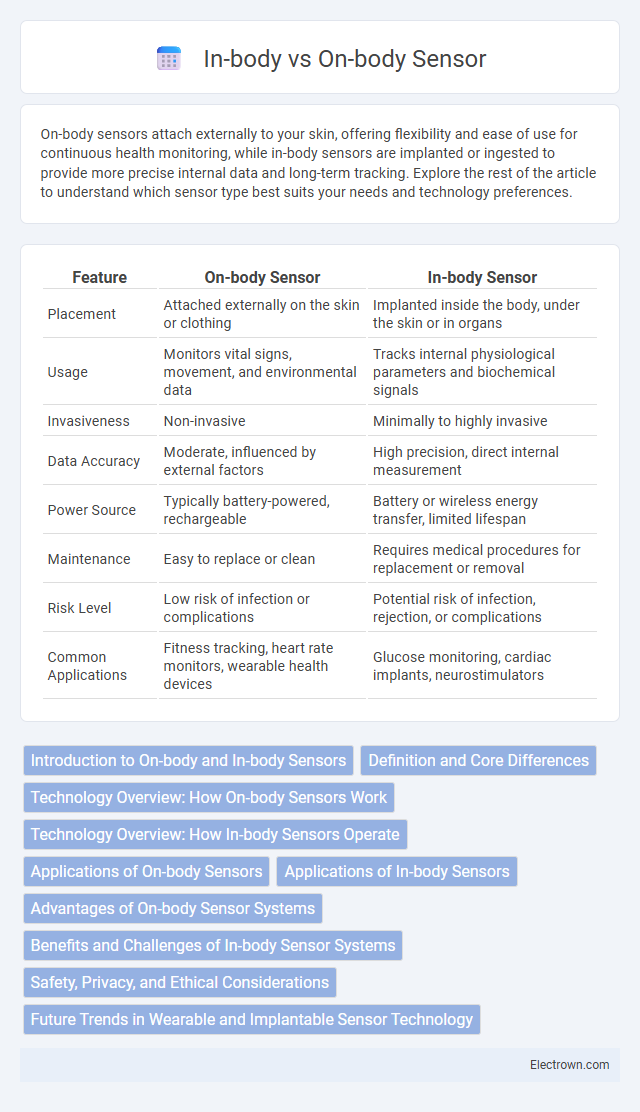On-body sensors attach externally to your skin, offering flexibility and ease of use for continuous health monitoring, while in-body sensors are implanted or ingested to provide more precise internal data and long-term tracking. Explore the rest of the article to understand which sensor type best suits your needs and technology preferences.
Table of Comparison
| Feature | On-body Sensor | In-body Sensor |
|---|---|---|
| Placement | Attached externally on the skin or clothing | Implanted inside the body, under the skin or in organs |
| Usage | Monitors vital signs, movement, and environmental data | Tracks internal physiological parameters and biochemical signals |
| Invasiveness | Non-invasive | Minimally to highly invasive |
| Data Accuracy | Moderate, influenced by external factors | High precision, direct internal measurement |
| Power Source | Typically battery-powered, rechargeable | Battery or wireless energy transfer, limited lifespan |
| Maintenance | Easy to replace or clean | Requires medical procedures for replacement or removal |
| Risk Level | Low risk of infection or complications | Potential risk of infection, rejection, or complications |
| Common Applications | Fitness tracking, heart rate monitors, wearable health devices | Glucose monitoring, cardiac implants, neurostimulators |
Introduction to On-body and In-body Sensors
On-body sensors are wearable devices placed on the skin's surface to monitor vital signs such as heart rate, temperature, and movement, offering non-invasive and continuous health tracking. In contrast, in-body sensors are implanted within the body to provide precise internal data like glucose levels or cardiac rhythms, enabling direct physiological monitoring. Your choice between on-body and in-body sensors depends on the required data accuracy, invasiveness, and the specific health parameters being tracked.
Definition and Core Differences
On-body sensors are wearable devices placed on the skin's surface to monitor physiological signals such as heart rate, temperature, and motion, whereas in-body sensors are implanted within the body to directly measure internal biological parameters like glucose levels or neural activity. Core differences include placement location, invasiveness, and the types of data collected, with on-body sensors providing non-invasive, external monitoring and in-body sensors offering continuous, precise internal measurements. In-body sensors often require biocompatible materials and surgical procedures, while on-body sensors emphasize comfort, flexibility, and ease of removal.
Technology Overview: How On-body Sensors Work
On-body sensors operate by adhering directly to the skin or clothing, utilizing technologies such as flexible electronics, bio-impedance, and photoplethysmography to continuously monitor physiological signals like heart rate, temperature, and motion. These wearable devices transmit real-time health data through Bluetooth or NFC to mobile apps or healthcare providers, enabling constant and non-invasive tracking. Advanced materials like stretchable circuits and adhesives ensure reliable skin contact and accurate biosignal detection under various physical conditions.
Technology Overview: How In-body Sensors Operate
In-body sensors operate through advanced biocompatible technologies that allow implantation within the human body to continuously monitor physiological parameters such as glucose levels, heart rate, or neural activity. These sensors use microelectromechanical systems (MEMS), wireless telemetry, and biofuel cells to transmit data in real-time to external devices while minimizing immune response. Their capability to provide precise, long-term internal insights surpasses on-body sensors, which rely on surface contact and are more susceptible to external environmental factors.
Applications of On-body Sensors
On-body sensors play a crucial role in continuous health monitoring, sports performance tracking, and rehabilitation by providing real-time physiological data such as heart rate, body temperature, and motion patterns. These sensors are commonly embedded in wearable devices like smartwatches, fitness bands, and adhesive patches, enabling non-invasive and convenient data collection. Their applications extend to remote patient monitoring and early detection of medical conditions, enhancing personalized healthcare and preventive medicine.
Applications of In-body Sensors
In-body sensors are primarily used in medical and healthcare applications such as cardiac pacemakers, glucose monitors, and implantable drug delivery systems. These sensors provide real-time monitoring of physiological parameters, enabling personalized treatment and early detection of health issues. Their seamless integration within the body enhances accuracy and reduces the risk of infection compared to external monitoring devices.
Advantages of On-body Sensor Systems
On-body sensor systems offer increased mobility and real-time monitoring, making them ideal for continuous health tracking and fitness applications. These sensors provide accurate biometric data by maintaining close contact with the skin, enhancing signal quality compared to in-body alternatives. You benefit from non-invasive installation and easy access, enabling quick adjustments and maintenance without medical intervention.
Benefits and Challenges of In-body Sensor Systems
In-body sensor systems offer precise physiological monitoring by being embedded directly within the body, enabling continuous data collection and real-time health insights critical for managing chronic conditions. These sensors provide enhanced accuracy and reduce signal interference compared to on-body sensors, but they face challenges such as biocompatibility issues, potential immune responses, and limited battery life requiring advanced power management. Furthermore, invasive implantation procedures pose risks and limit widespread adoption, necessitating ongoing innovations in minimally invasive technologies and long-term device reliability.
Safety, Privacy, and Ethical Considerations
On-body sensors offer enhanced safety by minimizing data interception risks through localized monitoring, whereas in-body sensors pose concerns of biocompatibility and invasive procedure complications. Privacy risks intensify with in-body sensors due to continuous, deeper physiological data collection requiring stringent ethical standards to prevent misuse. Your informed choice involves balancing personal safety with ethical implications and robust privacy protections inherent in sensor technology.
Future Trends in Wearable and Implantable Sensor Technology
Future trends in wearable and implantable sensor technology emphasize miniaturization, enhanced biocompatibility, and improved energy efficiency for both on-body and in-body sensors. Innovations in flexible electronics and advanced materials enable seamless integration with the human body for continuous health monitoring and real-time data collection. Your health management will benefit from AI-driven analytics that optimize sensor accuracy and personalized feedback for proactive care.
On-body vs In-body Sensor Infographic

 electrown.com
electrown.com